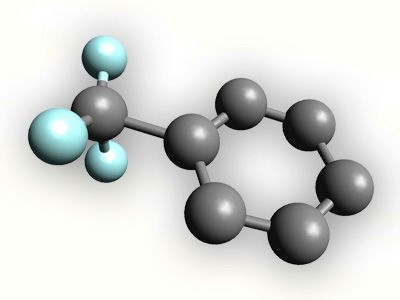Some drugs may be more effective the longer they last inside the body. To prevent such drugs from being broken down too rapidly, pharmaceutical manufacturers often attach a fluorine-containing structure called a trifluoromethyl group. However, the processes now used require harsh reaction conditions or only work in a small number of cases, limiting their usefulness for synthesizing new drug candidates for testing.
Now, MIT chemists have designed a new way to attach a trifluoromethyl group to certain compounds, which they believe could allow pharmaceutical companies to create and test new drugs much faster and potentially reduce the cost of drug discovery.
The new synthesis, reported in the June 25 issue of Science, should have an immediate impact, says David MacMillan, a Princeton University chemistry professor who was not involved in the research.
“Overnight, people are going to start using this chemistry,” says MacMillan. “Every single person in the pharmaceutical industry who makes molecules that incorporate fluorine to test as drugs has needed this reaction for a very long time.”
MIT Chemistry Professor Stephen Buchwald, who led the research team, says achieving the synthesis has been a long-standing challenge for chemists. “Some people said it couldn’t be done, so that’s a good reason to try,” says Buchwald, the Camille Dreyfus Professor of Chemistry at MIT.
Eun Jin Cho, a postdoctoral associate in Buchwald’s lab, is the lead author of the paper. Other authors are graduate student Todd Senecal, postdoctoral associates Tom Kinzel and Yong Zhang, and former postdoctoral associate Donald Watson, now an assistant professor of chemistry at the University of Delaware.
Fluorination
The trifluoromethyl group (abbreviated CF3) is a component of several commonly used drugs, including the antidepressant Prozac, arthritis medication Celebrex and Januvia, used to treat diabetes symptoms.
When foreign compounds such as drugs enter the body, they get sent to the liver, where they are broken down and shipped on to the kidneys for excretion. However, CF3 groups are hard for the body to break down because they contain three fluorine atoms. “Fluorine is not really a component of things we eat, so the body does not know what to do with it,” says Kinzel.
CF3 groups are also a common component of agricultural chemicals such as pesticides. To add a CF3 group to organic (carbon-containing) molecules, chemists often use hydrogen fluoride under conditions that might produce undesired reactions among the many structural components found in complex molecules like pharmaceuticals or agrochemicals.
With the new reaction, the CF3 group can be added at a much later stage of the overall drug synthesis. The reaction can also be used with a broad range of starting materials, giving drug developers much more flexibility in designing new compounds.
Work on the new synthesis was funded by the National Institute of General Medical Sciences, one of the National Institutes of Health.
A catalytic process
Chemists have been trying to find a widely applicable catalytic method to attach CF3 to aryl compounds (compounds containing one or more six-carbon rings) for a couple of decades. Some have achieved different parts of the reaction, but none successfully put all the pieces together to arrive at a method that is applicable for a wide range of different aryl compounds. The major challenge has been finding a suitable catalyst (a molecule that speeds up a reaction) to transfer the CF3 entity from another source to the carbon ring.
CF3– (trifluoromethyl negative ion) tends to be unstable when detached from other molecules, so the catalyst must act quickly to transfer the CF3 group before it decomposes. The MIT team chose to use a catalyst built from palladium, a silvery-white metal commonly used in catalytic converters. The MIT team is not the first to try palladium catalysis for this reaction, but the key to their success was the use of a ligand (a molecule that binds to the metal to stabilize it and hasten the reaction) called BrettPhos, which they had previously developed for other purposes.
Coming up with a useful reaction required much testing of different combinations of palladium, ligand, CF3 source, temperature and other factors. “Everything had to match up,” says Senecal.
During the reaction, a CF3 group is transferred from a silicon carrier to the palladium, displacing a chlorine atom. Subsequently, the aryl-CF3 unit is released and the catalytic cycle begins anew. The researchers tried the synthesis with a variety of aryl compounds and achieved yields ranging from 70 to 94 percent of the trifluoromethylated products.
In its current state, the process is too expensive for manufacturing use. For drug discovery, however, it may lower overall costs because it streamlines the entire synthesis process. “For discovery chemistry, the price of the metal is much less important,” says Kinzel.
All of the reaction components are commercially available, so pharmaceutical and other companies will immediately be able to use this method.
MIT chemists’ answer to long-standing problem could have a big impact on pharmaceutical business.
Publication Date:

Caption:
In this model, trifluoromethyl is attached to a ring of six carbons (known as a benzene ring). The gray balls represent carbon atoms, and the blue balls represent fluorine. (Hydrogen atoms attached to the benzene ring are not shown.)





